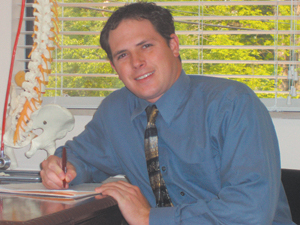A HEALTHY DAY
 Low Back Pain
Low Back Pain
“Lumbar Disc Herniation”
One of the most common causes of low back pain is a herniated disc. When most people hear “disc herniation” they have a perception that they need emergency care or surgery right away. They also think that they need to get an MRI to diagnose a herniated disc. This is true to some extent, however, in most cases a herniated disc can be cured with conservative care. In this article I will go over some anatomy, the diagnosis, causes, and treatment of a disc herniation. This article will also provide you with preventative ideas along with when you should go to the ER or get conservative care. Now these views are strictly mine based on clinical experience, various textbooks and journals I have read and studied over the years. If you do not fit any of the criteria that are listed in this article, but you still feel as though you should see someone, do not hesitate to do so. This article is designed to enlighten you about some of the common problems and causes, not to necessarily diagnose you.
In this article I am going to use the term inter-vertebral disc to describe the disc properly. These discs lie between each vertebrae in your spine. Their purpose can be related to the shock absorbers in your car. They absorb forces brought on by activity and gravity while protecting your vertebrae from touching one another. Each disc consists of two parts; a middle part consisting of proteoglycans that absorbs water and the outer part consisting of cross fibers, which are layered in opposite directions to give strength to the disc. A disc herniation occurs when that repetitive or extreme forces in one area push the inner fluid out and cause microtears in the outer area (annulus fibrosis). Eventually this forms a bulge, which can disrupt structures around the disc that in turn causes pain. If this bulge pushes out too much it can impinge on a nerve root coming out of the vertebrae and cause pain locally. If it gets worse it can cause pain to shoot down or refer to areas that the nerve innervates.
Before an MRI or x-rays are to be ordered it is necessary for a patient to go through an examination and if a patient has severe symptoms, no symptoms, or needs to rule out any other possible problem, then an MRI would be necessary. A classic presentation of a herniated disc consists of a patient complaining of low back and leg pain that often occurs below the knee, but can also be around the area of the hip. It is often a sudden onset from a bending and/or twisting maneuver. I also find a history of several occurrences of low back pain that has been resolved. Pain is often worse with bending over and a patient sometimes has muscular weakness in the leg or foot.
Most disc herniations are caused from repetitive lifting by bending over with some twisting motions involved. It can also be caused from prolonged sitting. People that are most at risk are truck drivers, weight lifters, construction workers, office/computer workers, athletes and anyone who incorporates the above previously mentioned activities in their lifestyle.
Surgery is rarely needed, but when it is necessary there are a number of procedures used that have great results. Otherwise most of the time surgery can be avoided with conservative care. One could go to physical therapy or a chiropractor for treatment. The difference between the two is that a physical therapist and a chiropractor can both do rehab but a chiropractor can diagnose the problem and use manipulation to treat the problem. In my office I first use anodyne therapy which decreases pain and inflammation around the disc. Then I use flexion/distraction technique, which avoids any side posture, fast twisting motions. I use a table because it distracts the spine relieving the pressure of the disc on other structures. I then continue rehab with the patient and show them proper techniques to avoid future problems. I send them home with exercises, a back brace if necessary, and supplements/homeopathic remedies to help relieve the symptoms. Patients in my office usually get relief the first day and are at least 85% better in 1-6 months depending on the severity of the problem and the amount of effort a patient does with their therapy at home.
It is important to know that a herniated disc is nothing to take lightly and professional care is necessary to treat the problem whether it is through surgery or conservative care. Just remember to listen to your body and get the care you need. By wearing a back brace, incorporating a proper diet, exercise, and education on proper lifting techniques you can prevent most disc herniations. Please read my upcoming articles for other detailed causes and treatments of low back pain. If you have any questions or need some advice on ways to prevent low back injuries, feel free to give me a call or e-mail at:
Dr. James Nill of Nill Family Chiropractic and Wellness Center, LLC.
4656 W. Jefferson Blvd. Suite 240.
Fort Wayne, IN 46804
260-459-2205,
drnill@nillfamilychiropractic.com.
Thank you and have a healthy day,
Dr. Nill
- Celebrating 20 Years Of Community At The Stand - April 12, 2024
- First Positive Case Of Chronic Wasting Disease In Indiana - April 12, 2024
- Southwest Allen County Schools Embark On Major Tree Plantings - April 12, 2024


